Value Stream Mapping - theoretical background
This page provides a theoretical foundation for value stream mapping. The content is an extract from the book Value Stream Mapping (https://www.amazon.com/Value-Stream-Mapping-Organizational-Transformation/dp/0071828915) that is one of the view books that combine value stream maps with knowledge work.
Not yet structured notes from the book
-
Deming: “If you can’t describe what you’re doing as a process, you don’t know what you’re doing”
-
Value stream mapping as a fundamental mindset for business success.
-
Book: Learning to See (mainly transformed the way many people viewed how work flows)
-
Powerful metric for analyzing processes in knowledge work environments is percent complete and accurate (%C&A)
-
Value stream mapping is about viewing the work system from macro level perspective in order to create organization-wide alignment. Visualize complex work systems so you can address the disconnects, redundancies and gaps in how work gets done.
-
vs. process level mapping (e.g. BPMN models) enables the people who do the work to design tactical improvements
-
deepens organizational understanding about the work systems that deliver value and support the delivery of value to customers, which aids in better decision making and work design
-
the quantitative nature of value stream maps provides the foundation for data-driven, strategic decision making
-
value stream maps reflect work flow as a customer experiences it (vs. internal focus of typical process-level maps)
-
when organizations see the interconnectedness of various departments and processes, they make better decisions, work together in more collaborative way, and avoid the common and costly trap of sub-optimization
-
…are working blueprints for how the organization functions and should drive discussions and decision making at all levels
-
…helps people to understand where they fit in an organization and fills fundamental need for connection. It instills holistic thinking.
-
-
A value stream is the sequence of activities an organization undertakes to deliver on a customer request. The sequence of activities required to design, produce and deliver a good or service to a customer, and it includes the dual flows of information and material.
-
It is a methodology to transform leadership thinking, define strategy and priorities and assure that customers are receiving high levels of value (versus focusing merely on reducing operational waste)
-
Starting point:
-
no one person can describe the complete series of events required to transform a customer request into a good or service
-
problem of adding processes that increase operational costs but doesn’t truly solve problems with root causes that reside upstream
-
problem of making improvements in one functional area only to create new problems in another area
-
…without a clear understanding about how an organization’s various parts fit together and how value is delivered to its customers
-
…without a clearly defined, externally focused improvement strategy that places the customer in the center
-
…the inclination to jump into the weeds and design micro-level improvements before the entire work system - the macro picture - is fully understood is key contributor to sub-optimization
-
-
begin with value stream mapping to align leadership
-
do Gemba walks and talk to people in their environments
-
break through inattentional blindness
-
experience physical conditions
-
socialize and foster buy in
-
do it 2x
-
-
focus on work systems design rather than individuals’ performance
-
look at high level activities that transform a request into some sort of deliverable
-
what inputs the worker receives, where they come from, who they pass work on to, and if work stops
-
5-15 serial process blocks as a good orientation for flight level
-
-
-
Types of value streams:
-
good or service is requested by and delivered to an external customer - a full customer-facing value stream
-
supporting the delivery of value; referred to as value-enabling or support value streams (e.g. recruiting, hiring, IT-support, budgeting process)
-
complex creative work from initial concept to executable design
-
product design can be viewed as a value stream segment if the design in required to fulfill a specific customer order
-
Wherever there is a request and a deliverable, there is a value stream
-
request to receipt; order to delivery; quote to cash;…
-
-
Time considerations
- a current state map is to get an understanding of how work is actually being performed in today’s environment (and as this is a snapshot in time it is also beneficial to do it at several time spots)
-
Determine value streams:
- by looking at the types of internal and external customer requests our organization receives and the number of variants of high-level process flows that each of those requests pass through
-
A value stream map:
- includes information flow, work flow and a summary timeline

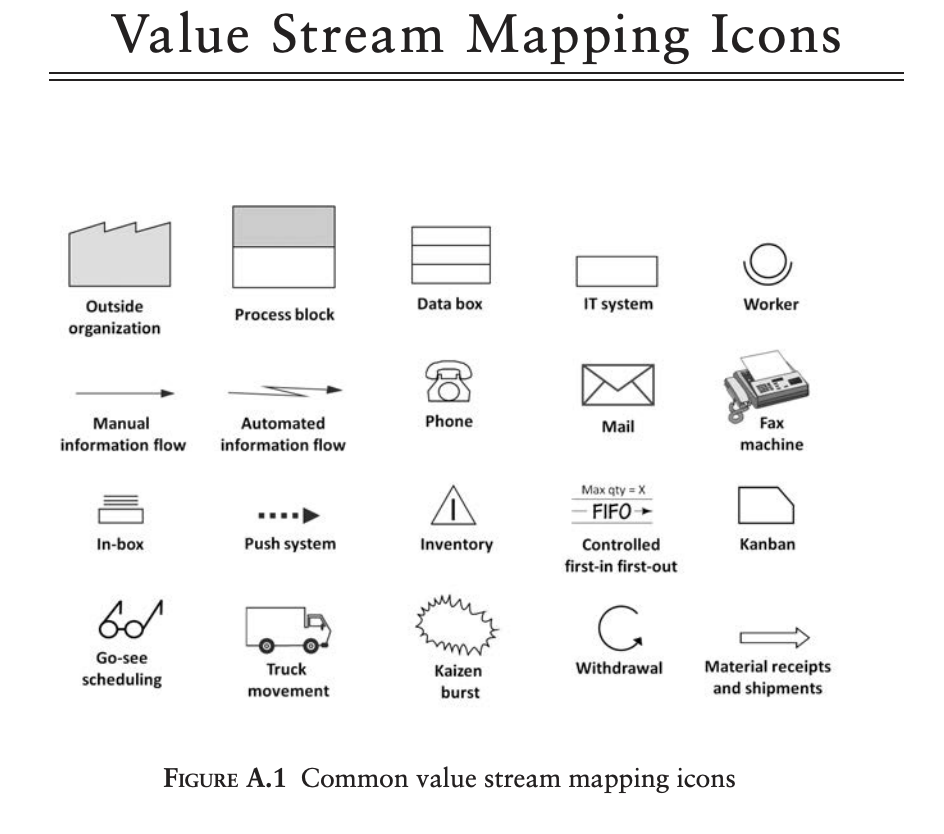
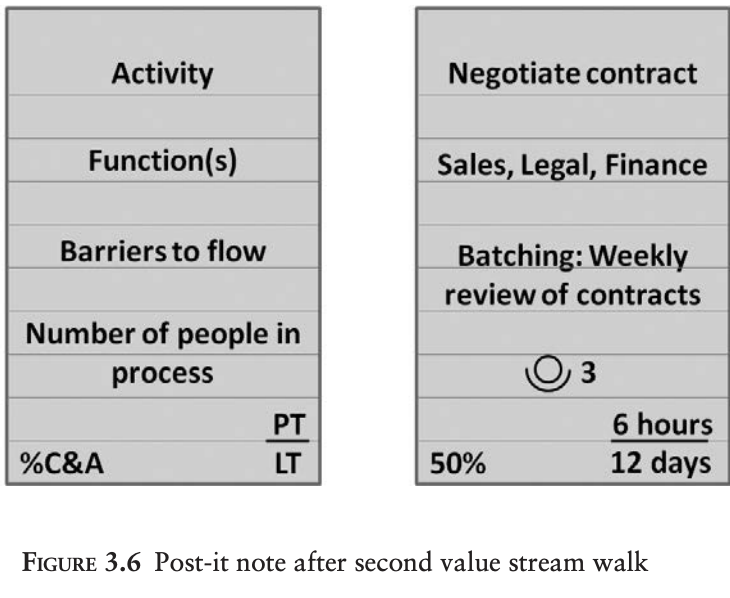
-
is cross discipline
-
value streams typically cut across functional departments and produce a specific deliverable based on a customer request or regularly scheduled need
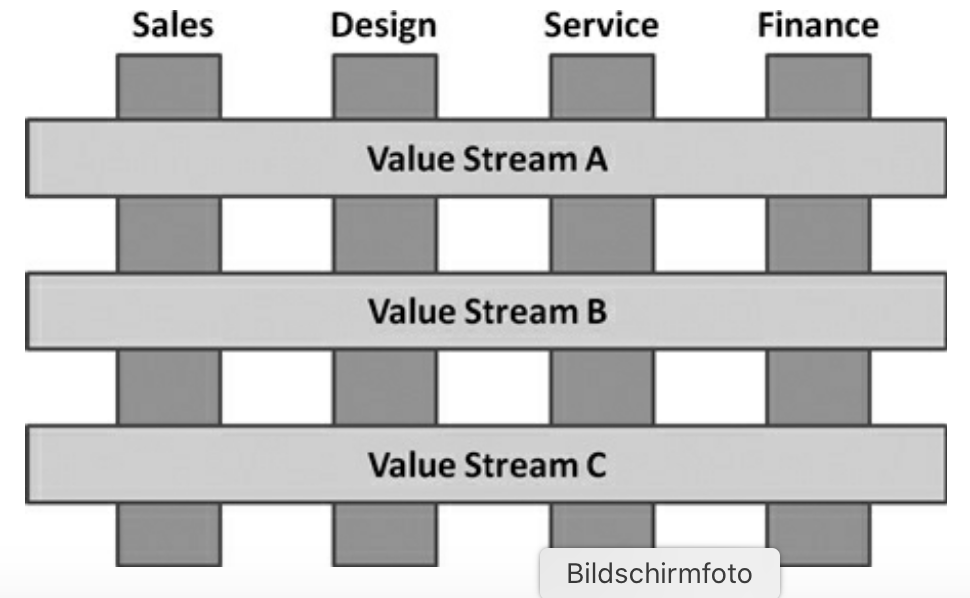
-
-
visualizes connections between internal suppliers and customers
-
value stream mapping is a team sport; it does little good for an organization to have one person learning to see; … and having one person decide how work should be done at a strategic level is a recipe for disaster
-
an suggested approach
-
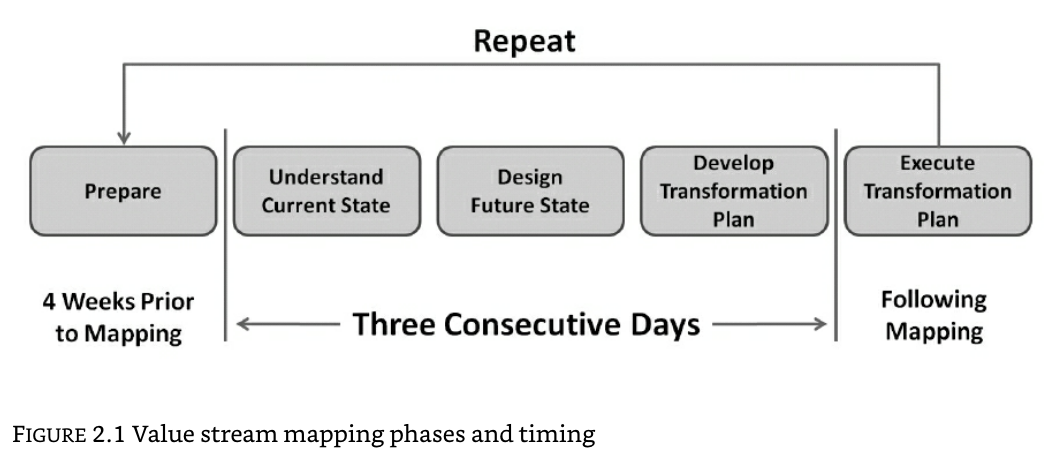
-
done by a mapping team with foundational understanding of Lean principles
-
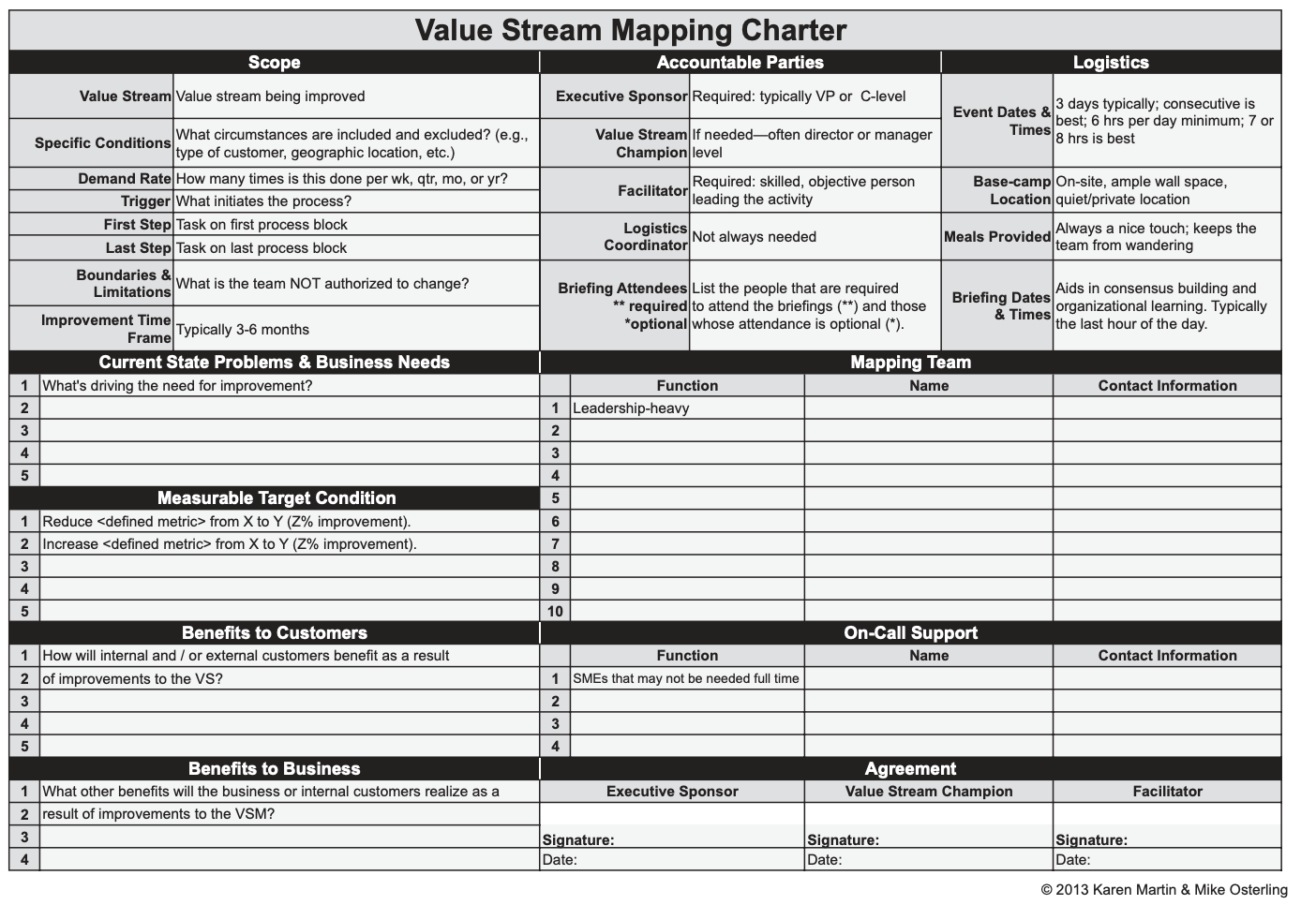
this charter provides an orientation what to look at and how to embed the value stream mapping activity into a change process
-
demand rate = volume of incoming work per time unit (day, week,…)
-
it’s impossible to truly understand current state performance without knowing the volume and types of work flowing through a system
-
it’s also critical to understand the degree of variation in demand: does work arrive regular, predictables cycles or is it erratic?
-
-
items - phrase it with verb-plus-noun format e.g. enter order instead of order entry
-
communicate top 2-5 reasons for tackling improvement across an entire value stream
-
the value stream champion is someone who’s accountable for performance of the entire value stream
-
-
don’t be afraid to narrow scope beyond comfort level
-
improving on macro level requires bold thinking
-
-
branching example (50% of items go through process 3)
-
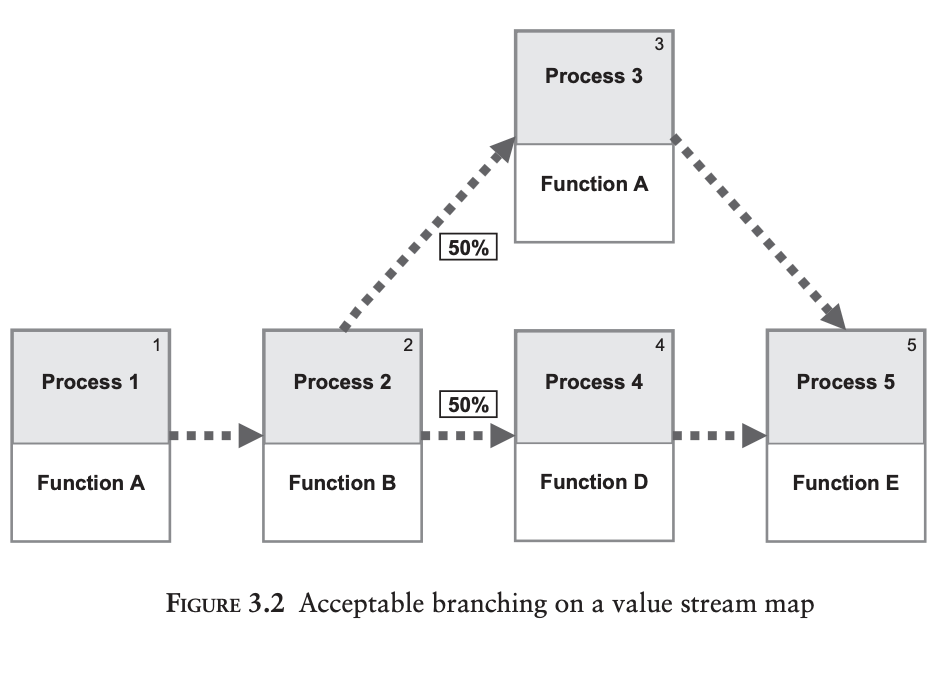
-
but limit branching and check if flight level is still macro level enough
-
parallel processing is also done via stacking but without the numbers
-
-
data
-
current and forecasted customer demand
-
quality reports that quantify internal or external issues
-
during the mapping one can also discover existent data gaps
-
process time (PT)
-
aka processing time, touch time, work time, task time
-
time it takes people to complete the process tasks to transform an input into an output for one unit of work; if the process workers could work on one item uninterrupted
-
for batches – include time to process the batch as if the batch only contained one unit
-
also includes talk time to clarify or obtain additional information
-
does not include waiting or delays
-
-
lead time (LT)
-
aka throughput time, response time, turnaround time
-
time from the moment work is made available to an individual, work team, department until it has been completed and made available to the next person/team in the value stream
-
includes queue time + delays + process time
-
-
percent complete and accurate (%C&A)
- by asking downstream what percentage of the time they receive work that’s “usable as is”
-
activity ratio (AR) - degree of flow in the value stream - calculated by total PT/total LT*100
-
rolled percent complete and accurate - %C&A_1 * %C&A_2
-
work in progress - accumulation of work between or within processes
-
-
value adding work (VA) - work that your external customer values and is willing to pay for or that’s a requirement of doing business with the customer
-
non value adding work
-
necessary (N) - activities an organization believes it must presently do to have a viable business. Referred to as value enabling
-
unnecessary - true waste - the customer doesn’t value it and the business doesn’t have to do it to remain a viable enterprise
-
-
batching
-
batch by size - holding until a specific number of items is accumulated
-
batch by frequency - performing an activity at a specific time
-
-
information flow
-
map systems and applications that each value stream interfaces with … to store/transmit data, produce work output, generate reports
-
to demonstrate technology related disconnects, voids and redundancies
-
-
some examples of value stream maps
- see starting from page 34 in
Sources
Learnings from implementation of Value Streams
In development teams we have certain parts of an application that are connected with the users journey. E.g. considering the onboarding flow (Kartoffel domain) one has the install –> welcome –> attribution –>register –>subscribe –>trial steps of a user. I was first thinking of this being the value stream but actually it is not. Every piece of it is touched in a separate value stream and one needs to check what of these steps is connected with creating (user) value and which ones are not. So the value stream is along the activities to change one of the steps from idea of the change until delivery of this change to the user.
